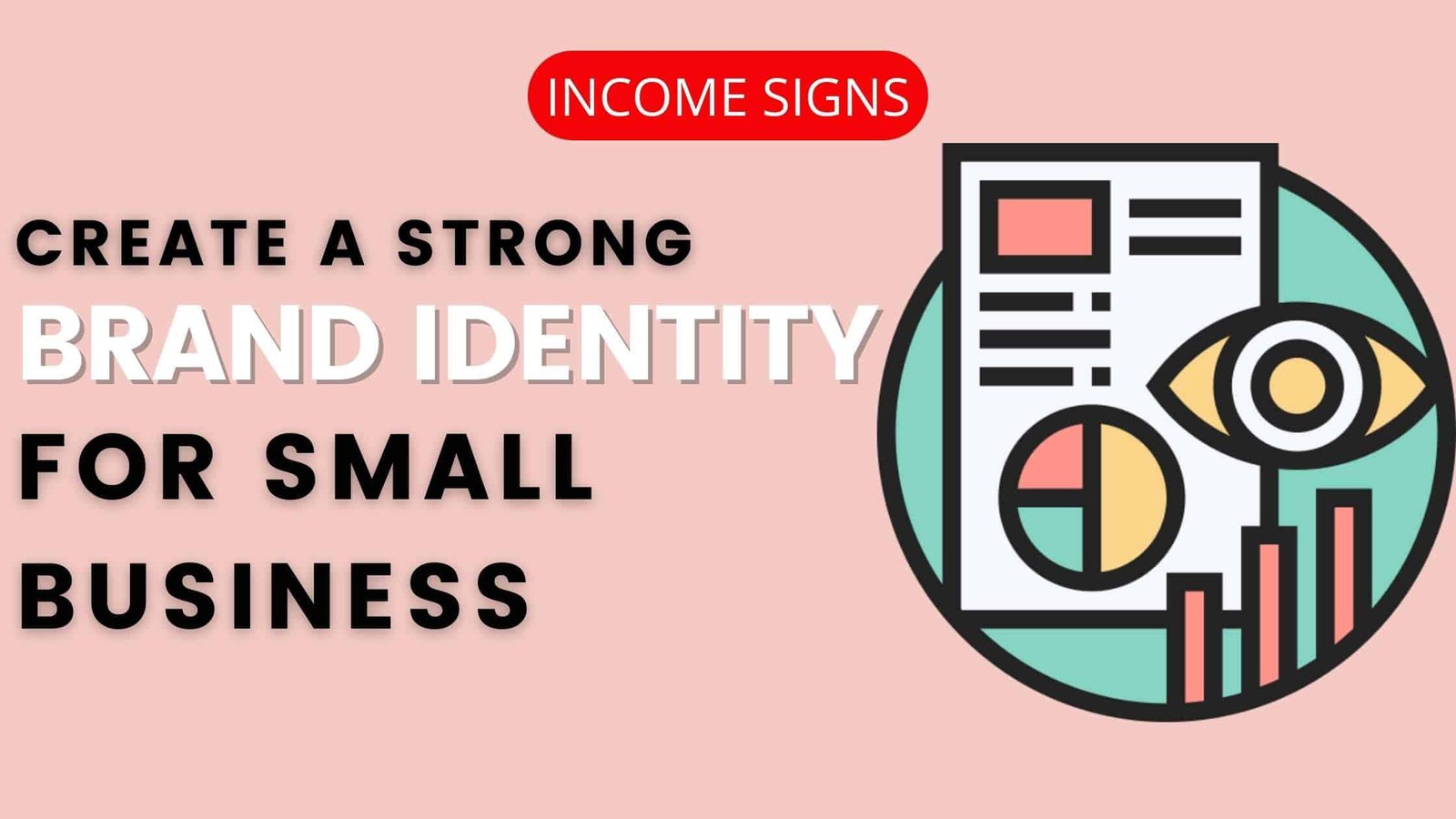Are you a small business struggling to stand out from the competition? If so, we have great news for you. Creating a strong brand identity doesn’t have to be hard! With these important points, you can quickly create a compelling and recognizable brand for your small business. So let’s get started with crafting your unique story!
In our previous blog, we discussed 7 Important Types of Brand Elements for your Business. This will be very useful for you to create a strong brand identity for your small business.
Creating a strong brand identity is one of the most important steps in developing a successful small business. A well-developed brand identity is how customers recognize and interact with your business. It conveys who you are, what your company offers, and what sets it apart from its competitors.
The first element of developing a strong brand identity is determining your target audience. Once you have established who you are targeting, you can start to craft the language, design elements, and visuals of your branding that will best represent your small business to that particular audience.
Honing in on these visual elements will help you create consistency throughout all of the materials used to promote and advertise your brand from website content to graphic designs to social media posts.
Developing an effective brand identity also involves defining and conveying the specific values and mission of your company in order to create a connection with potential customers. This includes crafting messaging that represents both what sets you apart from the competition and showcases why customers should trust and engage with your small business.
This could mean anything from highlighting unique features about certain products or services or being intentional about how you communicate with customers across all platforms reinforcing trustworthiness and expertise via quality content should be paramount as part of an effective branding strategy.
An effective branding strategy should include measuring feedback on how effective the messages and visuals created have been in reaching target audiences. Adapting strategies based on this feedback increases chances for success as customers interact more directly with brands leading to higher customer loyalty over time.
Defining Your Brand

The first step to creating a strong brand identity for your small business is to define and clearly articulate your brand. You need to establish who you are, what makes your company unique, and what kind of emotional connection you want customers to have with your products or services.
Your messaging, visuals, strategy, and tone should all be informed by the definition of who you are as a company.
Your brand definition should encompass principles such as purpose, values, mission and vision statement, core message, and customer promise. These elements coalesce into a strong brand story that people can connect with and helps separate your business from the crowd.
It’s important to go beyond stating what you do in order to create a powerful and resonant brand identity; focus on establishing why you do it and how this makes you different from other businesses in the same space.
Asking yourself questions such as “Why did I start this business?”, “What do I stand for?” Defining the personality of your company is it fun-loving or serious? will help provide clarity when it comes to choosing fonts and colors for design purposes.
What values does your business already represent? How can they be expressed visually in terms of logo design, font choice, etc.? Posing these questions can help build a strong foundation for the subsequent stages of creating an effective brand identity for small businesses.
Establishing Your Brand Values

Establishing your brand values is essential for creating a strong identity. Firstly, it is important to think about what you want your brand to represent and stand for. Values such as quality, innovation, reliability, and friendliness are good starting points. Consider how you want consumers to view your products and services when making decisions on what values to focus on.
Once you have established your core value focus points, think about how these values will be translated into everything from your website design, customer service protocol, and company blogs. Use visuals and storytelling to show customers how you stand out from competitors and establish an emotional connection through consistency in brand communication.
Communicate clearly why potential customers should choose your products or services rather than those of another company with the same offerings by creating memorable stories based on the core values you are centered around.
Regularly review the core values of your brand to make sure they still fit with who you are as a business, what has been successful in the past, and any changes that could be made going forward this will help give valuable clarity when constructing the future communications aimed at engaging with customers and other stakeholders alike.
Crafting Your Brand Message

Creating a strong brand identity is essential for any small business. It allows you to differentiate yourself from your competition and create a lasting impression in the minds of customers. To build a strong brand identity, you need to work through and understand the core elements before further refining them:
● Mission: What is your mission statement? What does your company stand for?
● Values: Define the values that will drive every aspect of your business.
● Message: Craft a message that’s clear, consistent, and meets customer needs.
● Voice: Choose a tone and style that reflects your values in all communications.
Your brand message should be tailored to reflect the kind of customers you want to attract, determine where they get their information, focus on the positive benefits of working with you and make sure it is emotionally engaging.
It should be crafted with language that resonates with your target customers and do an effective job of presenting your values in a compelling way. Remember to consider both what you’re saying as well as how it’s being said.
Designing Your Brand Visuals

Your visual branding should be a reflection of your mission and values. To ensure that your visual brand identity is consistent, create a style guide that outlines the specific shapes and type fonts (including size, color, and spacing) to use when creating marketing materials.
Create a logo that visually represents your brand identity. Your logo should be simple yet memorable and easy to recognize across all marketing channels it appears in. Make sure that you also use color effectively as it can help reinforce your branding message.
You should also design other visuals such as business cards, stationery packs, brochures, videos, and any other content related to websites or social media platforms try to remain consistent with your theme throughout all these materials.
Utilize the help of graphic designers if needed as they will ensure that all aesthetics follow through from idea conception to finished product in order for you to have great visuals for your brand identity.
Building Your Brand Presence

Strong brand identity forms an integral part of any successful business. While larger businesses make use of extensive marketing campaigns and brand recognition strategies, Small Businesses may find themselves at a disadvantage as they often have less financial resources available for undertaking such activities.
However, this does not mean that smaller businesses cannot create or strengthen their brands. There are many ways to build your brand presence effectively with limited resources.
Above all, consistency is key when it comes to creating a strong brand identity you must be consistent in the way you represent your brand across different mediums, including your website design and logo design. Your message should also be clear and easy to understand so that customers can quickly identify what your business stands for.
Establishing an online presence is one of the most important steps for building your brand identity. This includes creating an active social media page, optimizing the website for search engines, and creating content such as blogs to engage visitors on your site. Paid digital advertising can also help bring more visibility to the small business brand name and bring in more leads over time.
You can also strengthen your small business’s branding through traditional marketing as well such as local events sponsorship or newspaper advertising campaigns depending on where the market serves most people. Who could potentially be interested in buying products or services from a particular business like yours directly or indirectly through referrals or recommendations by satisfied original customers.
Which is even better than the first option but may not be feasible initially due to the lack of a substantial customer base leading to up-front investments. However, this route may actually yield significant profits over time while also increasing familiarization amongst local communities leading up to the successful establishment of strong branding.
Eventually yielding steady profits over time if done right in conjunction with online branding strategies over time.
Connecting with Your Audience

A strong brand identity is essential for any small business to establish trust and loyalty with its customers. To create a connection with your audience, it’s important to determine the target audience and ensure that you are delivering a consistent message across all platforms.
Start by determining what makes your small business unique. Develop a unique and compelling story to explain why you do what you do that resonates with your target audience. Your brand story should reflect the core values of your company, provide insight into its products or services, and should captivate individuals within the target market.
Consider striving for an emotional connection instead of simply highlighting product features or benefits – evoke positive emotions such as joy, pride, or happiness in order to stand out from competitors.
Next, create strategic content tailored around those core goals while staying true to the overall brand message. This could contain written content like brochures or blog posts; visuals such as infographics or logo designs; video content like animation or tutorials, and audio materials such as podcasts.
Producing content based on your values can help build a strong relationship between you and potential customers who share these same beliefs/values. Ensure social media channels stay unified with the core values that have already been established – this further adds to the credibility and reinforces the brand messaging recipients may have seen elsewhere in their research process.
Measuring Brand Success

When it comes to building a strong brand, measuring the success of your efforts is essential. There are a number of ways that you can gauge brand strength, including analyzing input and output metrics, tracking your brand’s social media mentions, utilizing customer feedback surveys, and monitoring online reviews.
Input metrics refer to measurements you can take before launching a campaign or product in order to determine if it will be successful. These metrics include evaluating industry trends and analyzing competitor strategies. Output metrics measure responses after the launch and can help you assess the effectiveness of activities such as ad campaigns or public relations initiatives.
Social media mentions track consumer conversations about your brand, allowing you to identify both positive and negative feedback. Customer feedback surveys are an effective way to get direct feedback from your customers and provide valuable insight into their thoughts about your company or products.
Online reviews can also reveal what works well for your target audience as well as areas that need improvement. Utilizing these different methods of measurement will help you determine how successful you have been in establishing and maintaining a strong brand identity for your small business.
Examples of Successful Strong Brand Identity for Small Business
Your brand identity can make or break your small business, so be sure to invest time and effort into crafting the perfect one. To help you get inspired, here are a few examples of successful strong brand identities for small businesses:
• Warby Parker: Their branding is simple yet sophisticated, with bold colors and minimalist shapes that evoke a sense of luxury.
• Glossier: Their branding is modern and fun, with bright colors and playful fonts that appeal to a younger audience.
• Toms Shoes: Their branding is focused on creating an emotional connection with their customers by emphasizing the company’s mission of giving back.
By taking inspiration from these examples, you can create a strong brand identity for your small business that will help you stand out from the competition and build a loyal customer base.
Remember, your brand identity should be unique to your company and reflect what makes it special. So get creative and get successful in your small business brand identity.
